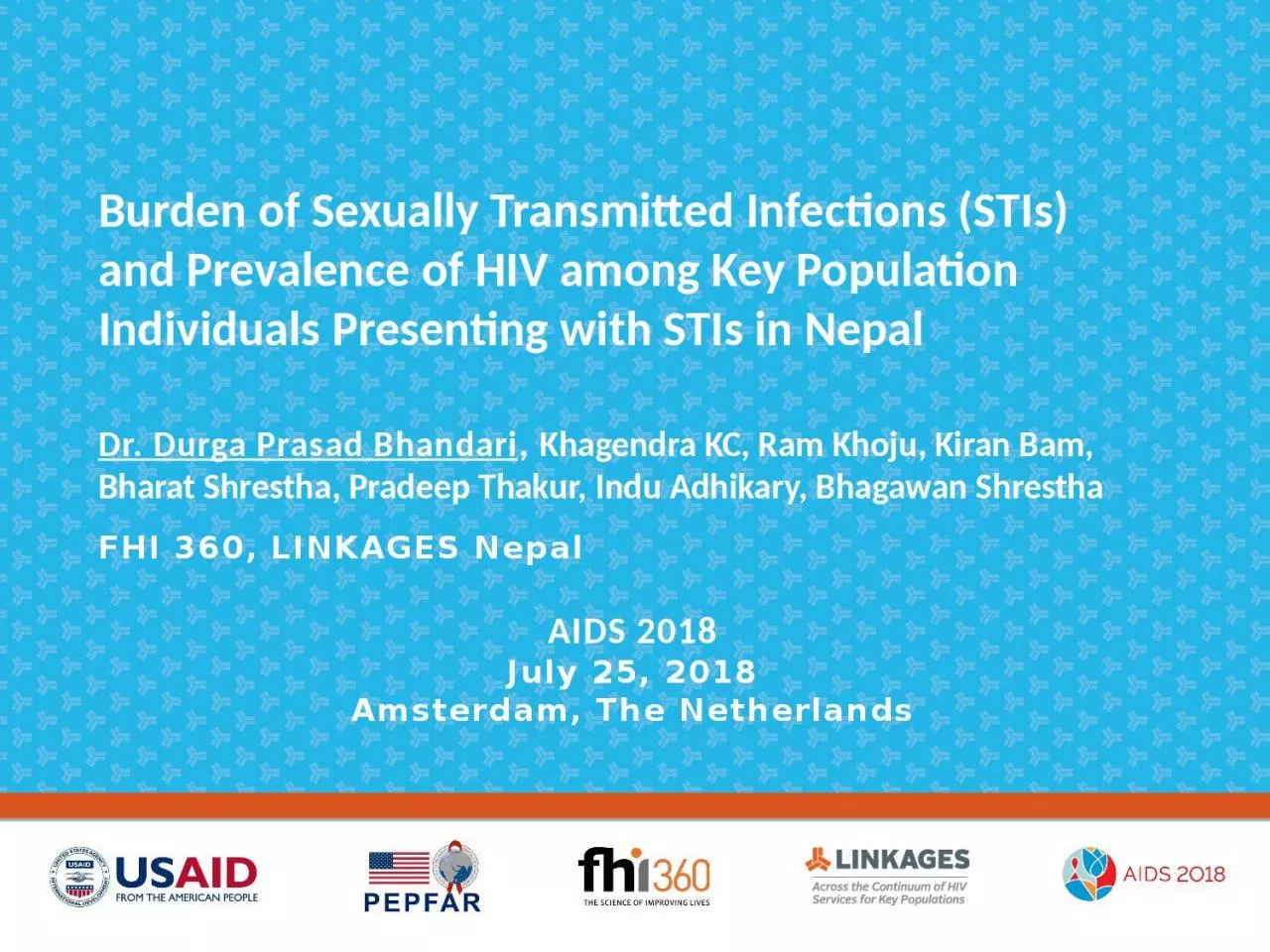

AIDS 2018 July 25 2018 Amsterdam The Netherlands Dr Durga Prasad Bhandari Khagendra KC Ram Khoju Kiran Bam Bharat Shrestha Pradeep Thakur Indu Adhikary Bhagawan Shrestha FHI 360 LINKAGES Nepal ID: 1009094
Download Presentation The PPT/PDF document "Burden of Sexually Transmitted Infection..." is the property of its rightful owner. Permission is granted to download and print the materials on this web site for personal, non-commercial use only, and to display it on your personal computer provided you do not modify the materials and that you retain all copyright notices contained in the materials. By downloading content from our website, you accept the terms of this agreement.
1. Burden of Sexually Transmitted Infections (STIs) and Prevalence of HIV among Key Population Individuals Presenting with STIs in Nepal AIDS 2018July 25, 2018Amsterdam, The NetherlandsDr. Durga Prasad Bhandari, Khagendra KC, Ram Khoju, Kiran Bam, Bharat Shrestha, Pradeep Thakur, Indu Adhikary, Bhagawan Shrestha FHI 360, LINKAGES Nepal
2. BackgroundGlobally, relatively little attention has been devoted to sexually transmitted infections (STIs).Nearly 1 million people get infected every day with any of four curable STIs: chlamydia, gonorrhea, syphilis, and trichomoniasis.Use of biomedical prevention methods (antiretroviral therapy, pre-exposure prophylaxis, post-exposure prophylaxis) may affect behavioral patterns and condom use, leading to increased STIs.
3. Overview of HIV Epidemic in NepalConcentrated HIV epidemicEstimated HIV prevalence: 0.15%Key populations (KPs) at risk of HIV: Female sex workers (FSWs), clients of FSWsPeople who inject drugs (PWID) Men who have sex with men (MSM), male sex workers (MSWs), transgender (trans) people Male labor migrants Committed to meeting UNAIDS goals of 90-90-90 by 2020 and ending AIDS epidemic as public health threat by 2030
4. HIV and STI Situation in NepalHIV Epidemic ZonesFSWPrevalence %MSM and Trans PeoplePrevalence %HIV SyphilisHIVSyphilisKathmandu Valley2.22.26.21.5Pokhara0.302.20.3Terai Highway Districts0.8510.38.29.4Sources: NCASC. Factsheet: HIV surveillance, Nepal. 2017. Available from: https://www.ncasc.gov.np/WAD2017/; Department of Health Services, Nepal. Annual report, 2016/2017. 2017.Proportion of patients visiting government outpatient clinics who have an STI*: 0.62%
5. LINKAGES Nepal (1/2)Stands for the Linkages across the Continuum of HIV Services for Key Populations Affected by HIV project, USAID and PEPFAR’s flagship project addressing HIV prevention, care, and treatment among key populationsBeing implemented in 16 districts in Nepal, October 2016–June 2019Provides HIV and STI prevention, diagnosis, and case management services to FSWs, clients of FSWs, MSM, MSWs, and trans peopleOffers all individuals presenting for STI services HIV testing and vise versa
6. LINKAGES Nepal (2/2)Closely coordinates and collaborates with governmentIs represented in national HIV technical working groupsObtains all diagnostic test kits, reagents, and medicines from the national logistics systemActively links people living with HIV (PLHIV) identified in LINKAGES clinics with government ART centers for treatmentFollows up PLHIV in the community through peer navigators
7. STI Case Management in LINKAGES NepalIncludes:Demand generation in community Counseling and syndromic management in clinicsSyphilis screening and treatment with benzathine penicillin Condom distributionPresumptive treatment of cervicitis (for FSWs only)Health care waste management
8. Burden of STIs and Prevalence of HIV (October 2016-September 2017)Total KP individuals screened for STIs: 23,454Total STI cases identified: 5,475Total HIV cases identified among STI patients: 42 (0.7%)Note: VDS = vaginal discharge syndrome; PID = pelvic inflammatory disease (lower abdominal pain syndrome); GUDS = genital ulcer disease syndrome; GW = genital warts; HSV = herpes simplex virus; UDS = urethral disease syndrome(Figures in light blue boxes represent HIV prevalence)
9. STI Burden among HIV-Positive Clients, N=42 (October 2016–September 2017)Genital warts
10. ConclusionsThe STI burden among KP program beneficiaries is high, and many KP members living with HIV are co-infected with an STI.Providing integrated services helps link a large number of KP individuals to needed STI services in this resource-limited setting. All individuals presenting for HIV testing should be examined, tested, and treated for STIs and vice versa.
11. Stay Connected with LINKAGESFollow LINKAGES on Twitter: www.twitter.com/LINKAGESproject Like the project on Facebook: www.facebook.com/LINKAGESproject Subscribe to the LINKAGES blog:www.linkagesproject.wordpress.com Subscribe to The LINK, LINKAGES’s quarterly project e-newsletter Check out LINKAGES’s quarterly research digest
12. Acknowledgments